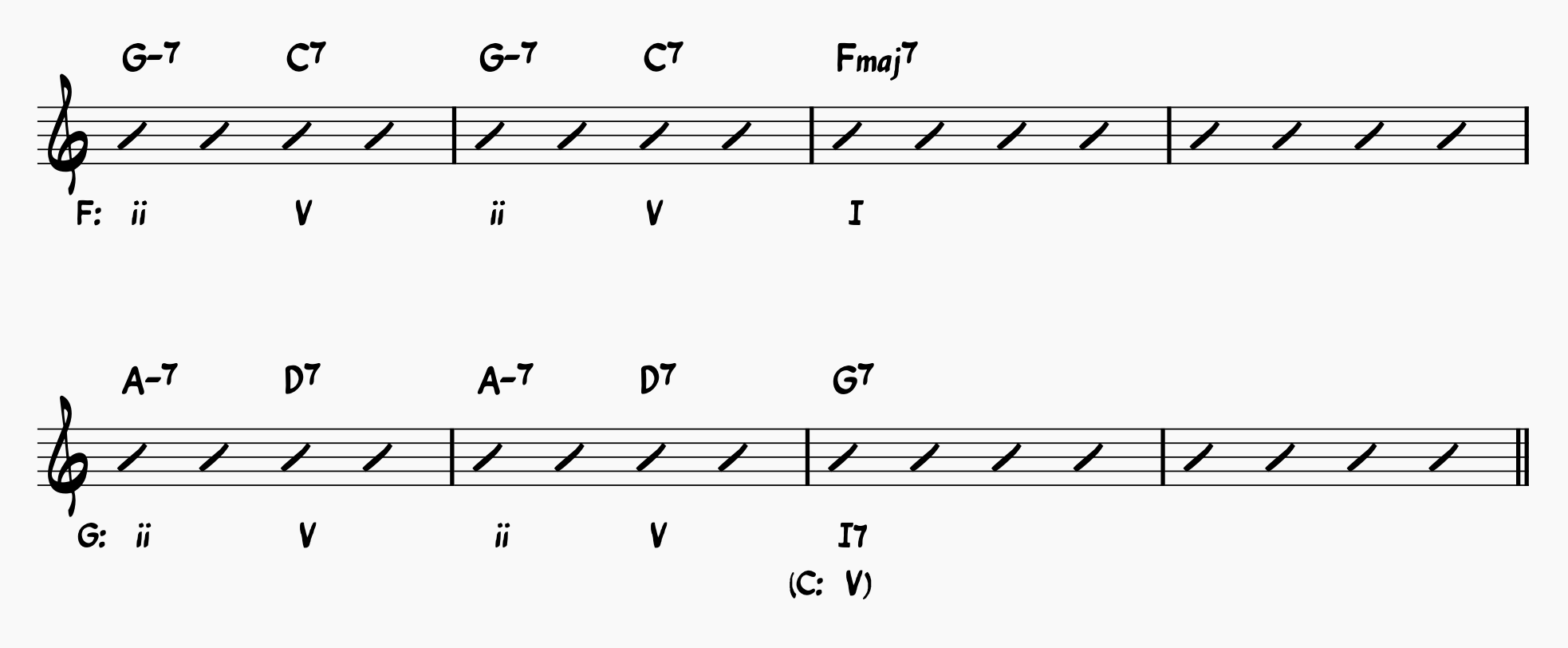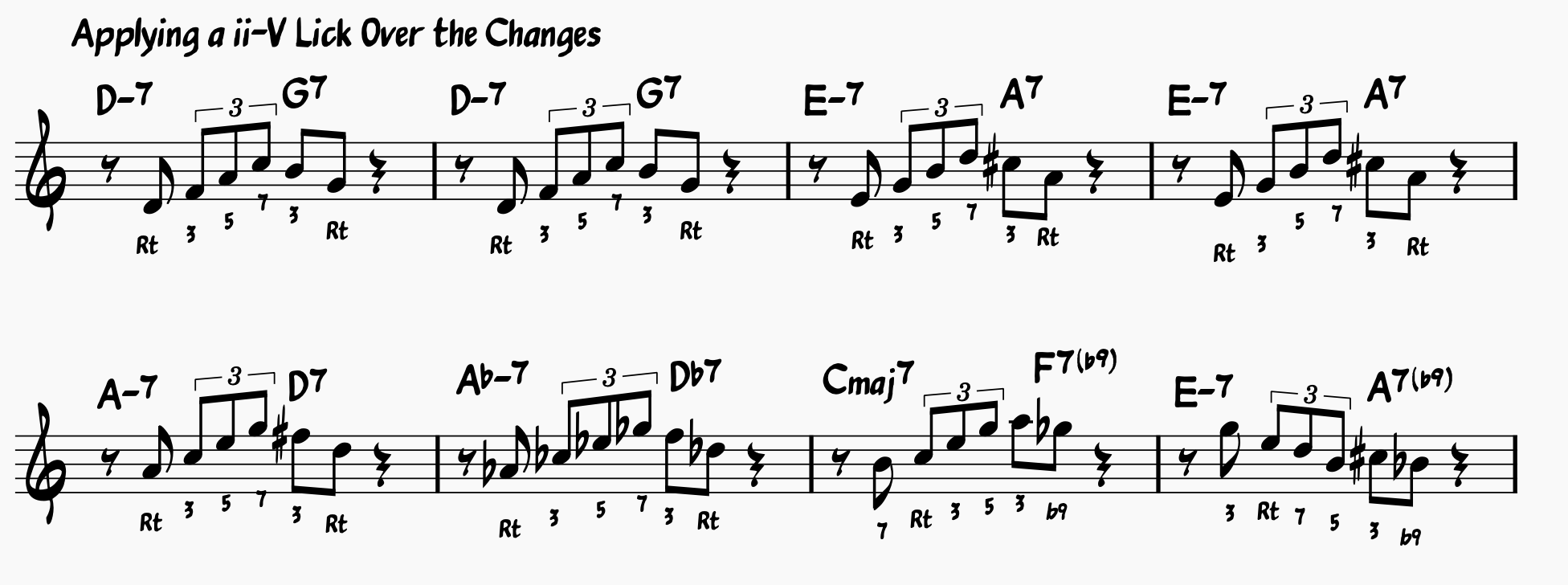If you want to learn to play “Satin Doll,” you’ve reached the right place! This post will equip you with all the information you need to successfully learn this timeless jazz standard (and remember it!)
Here’s what we’ll cover:
- The history of “Satin Doll”
- Why “Satin Doll” is a tune you need to know
- How to approach learning this jazz standard (and all standards)
- A harmonic analysis of the tune
- Plenty of improvisation tips to help you play over the changes!
If this is the type of jazz content you crave, then you need to check out the Learn Jazz Standards Inner Circle! The Inner Circle is designed to help members overhaul their jazz chops and musicianship, pushing them to become stronger and more expressive jazz musicians.
If you want to take your jazz playing to the next level, then you need to check out the Inner Circle.
Use the table of contents if you want to get right to the music analysis!
Table of Contents
The History of the Duke Ellington and Billy Strayhorn Tune “Satin Doll”
“Satin Doll” was written by the legendary duo Duke Ellington and Billy Strayhorn, with lyrics by Johnny Mercer. Duke Ellington first introduced the instrumental version of the piece in 1953, with Johnny Mercer writing lyrics after the tune became a hit for the Duke and his Orchestra.
Since then, “Satin Doll” has become a bonafide jazz classic among instrumentalists and singers.
While Duke Ellington is a household name, much of his compositions (as much as 40%) were heavily influenced by the contributions of his lesser-known close collaborator and musical partner, Billy Strayhorn.
Musicologists and historians often debate what ideas originated from the Duke and what ideas came from Billy Strayhorn because the two were so intertwined in the composition process.

Image sourced from: https://americanhistory.si.edu/exhibitions/duke-ellington-and-billy-strayhorn-jazz-composers
Strayhorn joined Ellington’s band in the late 1930s and became an integral part of its sound, contributing numerous compositions and arrangements. Duke Ellington and Billy Strayhorn’s partnership was one of the most fruitful in jazz history, and “Satin Doll” is one of many great examples of this duo’s creative output.
In fact, “Satin Doll” was such a hit that it was usually the closing number during Duke Ellington concerts.
Why “Satin Doll” Is A Tune You Should Know
“Satin Doll” has everything you’d want in a jazz standard—an infectious melody, beautiful harmony, and an incredible feel that one comes to expect from the Ellington orchestra. Over the years, this song has been adopted and adapted by countless jazz musicians and has been recorded in many contexts, from solo piano renditions to big band arrangements.
Why You Should Learn “Satin Doll:”
- This is a tune that singers will often call, and you can bet you’ll encounter it at one point or another at gigs or jam sessions.
- For instrumentalists, “Satin Doll” is a great vehicle for practicing improvisational concepts. The entire tune is written using a series of ii-V chord progressions, which is perfect for practicing licks and lines over.
- For guitarists and pianists, “Satin Doll” is a great tune to practice chord melodies over. The functional harmony and logical melody make this tune a relatively easy yet rewarding tune to shed.
So we know why we should learn the Duke Ellington song “Satin Doll,” but what’s the best way to learn it?
The Best Way To Learn “Satin Doll”
There isn’t one definitive way to learn a jazz tune. However, there are some best practices you can follow to ensure you understand the music inside and out so that it sticks. The following tips are designed to help you learn jazz standards off the chart at first.
You’ll develop a stronger emotional connection to the music if you listen rather than read!
Step 1. Learn the Melody By Ear
You should start by learning the melody by ear away from your Real Book. Specifically, you want to listen to as many versions of “Satin Doll” as possible. Though it is the original, the Duke Ellington and Billy Strayhorn version is far from the only interpretation.
From guitarist Wes Montgomery to trumpeter Clark Terry, there are so many interesting instrumental versions, but you shouldn’t limit yourself to only instrumental versions.
When Johnny Mercer wrote lyrics for “Satin Doll,” he opened the floodgates for many interpretations by a whole range of vocalists, from Frank Sinatra to Ella Fitzgerald. Vocalists, like instrumentalists, have a unique way of infusing the melody with their own personalities.
You should learn the melody by listening to a whole bunch of versions and avoid the lead sheet for the time being. Yes, this might force you to learn it in a few different keys, but different keys are like broccoli and carrots for jazz musicians—they’ll only make you a healthier, more well-rounded musician!
- First, be able to sing the melody!
- Then, take it to your instrument.
Step 2. Learn the “Satin Doll” Chord Progression
After learning the melody, it’s time to tackle the chord progression! The song form is AABA and is 32 measures long.
The chords of “Satin Doll” are easy to learn because the harmony is extremely functional. The original Duke Ellington version of the song is in the key of C major, so that’s the key we’ll use when talking about the chords.

The A Section of Satin Doll
There are two ways to think about the harmony of “Satin Doll.”
(Mostly) C Major
One way to think of the chord progression is to see Satin Doll as mostly in the key of C with some secondary dominants sprinkled in—these are the A7s and D7s you’ll see in the chart below. In the sixth measure, we briefly leave the key of C when playing a chromatic ii-V down to the I-IV7-iii-VI7 turnaround on the last two bars.

A Series of ii-Vs in Different Keys
Another way to see the “Satin Doll” changes is to group the different ii-Vs into different tonal centers rather than seeing various dominant chords as borrowed harmony. This perspective might make it easier for beginner improvisers to organize the different tonal centers implied by the harmony.
Using this perspective (shown in parentheses in the chart above), “Satin Doll” starts with ii-Vs in C for the first two measures and then moves to ii-Vs in D for the next two measures. In the fifth measure, you get a ii-V in G followed by a ii-V a half step lower in Gb for the sixth measure.
We’ll revisit this second perspective later when playing through the changes.
The B Section of Satin Doll
The B section of “Satin Doll” is more straightforward than the A section. The song leaves the key of C and moves to F major for the first four bars of the B section. Then, we move to the key of G for two bars, with a series of ii-Vs (the Am7-D7s), before heading to a G7 for the last two measures, which will bring us back to the key of C for the final A section.

Need a refresher on 7th chords? Check out our Ultimate Guide to 7th Chords.
Step 3. Practicing Improvisation Over Satin Doll
Satin Doll is a great tune to practice if you need to work on moving ii-V-I licks around different tonal centers. The tune is a ii-V Frankenstein, making it the perfect practice vehicle.
1. Playing Scales Over the Changes
The following scale map divides the first eight bars into different tonal centers and shows you which of the major modes you can use to capture the harmony of the moment.

To refresh the modes of the major scale, check out our guide to the musical modes.
2. Playing Seventh Chord Arpeggios Over the Changes
Playing arpeggios over a tune helps you hear the harmony linearly. For this particular exercise, the arpeggios ascend and descend (except for the last two bars). Feel free to switch up which chord tones you start on and the ascending/descending pattern you choose.

3. Playing Guide Tones and Target Notes Over the Changes
Another way to practice the harmony of a tune is to focus on the guide tones or target specific chord tones. In the following chart, we target the 3rd and 7th of each chord.

4. Playing a ii-V Lick Over the ii-Vs
Here is a practice lick you can use to navigate the changes of “Satin Doll.” Beneath each measure, you’ll notice the chord tones each note is hitting. The last two bars switch things up by introducing altered dominant chords!
Check out this post to learn more about the different types of dominant chords you’ll encounter while playing jazz standards!

Check out this podcast episode on playing ii-V-Is for more major ii-V-I improvisation ideas.
Dive Deeper Into Jazz. Join the Learn Jazz Standards Inner Circle.
Ready to take your jazz playing to the next level?
The Inner Circle has everything you need to master the jazz language and improve your musicianship skills. With over ten years of incredible jazz education resources, you’ll unlock the materials and mindset necessary to become the best jazz player you can be.







